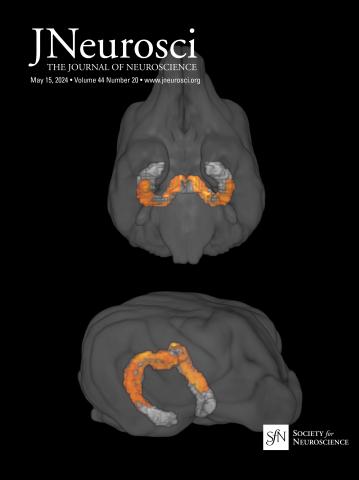PVN-NAc shell-VP circuit OT and OTR neurons regulate pair bonding via D2R and D1R.
IF 4
2区 医学
Q1 NEUROSCIENCES
引用次数: 0
Abstract
Previous studies have found that several neurochemicals are involved in formation of pair bonding. However, circuit mechanisms underlying pair bonding, especially how these chemicals interact in this circuit regulate pair bonding, remains unclear. Using male mandarin voles, the present study shows that cohabitation with a partner increased frequency of spontaneous excitatory postsynaptic current (sEPSC) of paraventricular nucleus (PVN) oxytocin (OT) neurons projecting to nucleus accumbens (NAc) shell. Optogenetic activation of PVN OT neurons projecting to the NAc shell reduced D2 medium spiny neurons (MSNs) activity, but increased activities of D1 MSNs in the NAc shell. Bath application of OT caused a long-term depression (LTD) of evoked excitatory postsynaptic current (eEPSC) in NAc shell D1/D2 MSNs in the no cohabitated male voles. This OT-induced LTD in the NAc shell D1/D2 MSNs was suppressed by 7 days of cohabitation. NAc shell oxytocin receptor (OTR) MSNs projecting to the ventral pallidum (VP) were D1R/D2R positive. Chemogenetic activation or inhibition of OTR MSNs in the NAc shell projecting to the VP facilitated or disrupted the pair bond formation respectively. The facilitatory effects of OTR MSNs activation on pair bond formation could be blocked by D2 antagonist, but not D1 antagonist. These results suggest that OT and OTR neurons in the PVN-NAc shell-VP circuit regulate pair bonding via different activities of D1/D2 MSNs.Significance Statement Pair bond is important for successful reproduction in monogamous species, while the mechanisms by which the neurochemicals interact to regulate formation of pair bonding remain unclear. Using whole cell patch-clamp recordings, we confirmed that cohabitation with opposite sexes alters the synaptic transmission of OT neurons in the PVN and the effects of OT on D1 and D2 MSNs in the NAc. We then unveiled that optogenetic activation of PVN OT neurons influence activities of D1 and D2 MSNs in the NAc shell and manipulation of VP-projecting OTR MSNs in the NAc shell affected pair bonding formation. Our findings identify that OT and dopamine system interact in the PVN-NAc shell-VP neural circuits modulate formation of pair bonding.PVN-NAc壳- vp电路OT和OTR神经元通过D2R和D1R调控配对键合。
先前的研究发现,几种神经化学物质参与了成对结合的形成。然而,配对成键的电路机制,特别是这些化学物质如何在这个电路中相互作用来调节配对成键,仍然不清楚。本研究以雄性田鼠为研究对象,发现与伴侣同居增加了伏隔核(NAc)壳上投射的室旁核(PVN)后叶催产素(OT)神经元的自发兴奋性突触后电流(sEPSC)频率。PVN OT神经元投射到NAc壳的光遗传激活降低了D2中棘神经元(MSNs)的活性,但增加了NAc壳中D1 MSNs的活性。OT对无同居雄性田鼠NAc壳D1/D2 msn诱发兴奋性突触后电流(eEPSC)有长期抑制作用。这种ot诱导的NAc壳D1/D2 msn中的LTD被同居7天抑制。NAc壳催产素受体(OTR)向腹侧pallidum (VP)的msn呈D1R/D2R阳性。在NAc壳中向VP投射的OTR msn的化学发生激活或抑制分别促进或破坏了对键的形成。D2拮抗剂可阻断OTR MSNs活化对偶键形成的促进作用,而D1拮抗剂则不能。这些结果表明PVN-NAc外壳- vp回路中的OT和OTR神经元通过D1/D2 MSNs的不同活性调节配对键合。配对结合对一夫一妻制物种的成功繁殖至关重要,而神经化学物质相互作用调节配对结合形成的机制尚不清楚。通过全细胞膜片钳记录,我们证实了异性同居改变了PVN中OT神经元的突触传递,以及OT对NAc中D1和D2 msn的影响。我们随后揭示了PVN OT神经元的光遗传激活影响NAc壳中D1和D2 MSNs的活性,而NAc壳中vp -投射OTR MSNs的操作影响配对键的形成。我们的研究结果表明,OT和多巴胺系统在PVN-NAc壳- vp神经回路中相互作用,调节成对结合的形成。
本文章由计算机程序翻译,如有差异,请以英文原文为准。
求助全文
约1分钟内获得全文
求助全文
来源期刊

Journal of Neuroscience
医学-神经科学
CiteScore
9.30
自引率
3.80%
发文量
1164
审稿时长
12 months
期刊介绍:
JNeurosci (ISSN 0270-6474) is an official journal of the Society for Neuroscience. It is published weekly by the Society, fifty weeks a year, one volume a year. JNeurosci publishes papers on a broad range of topics of general interest to those working on the nervous system. Authors now have an Open Choice option for their published articles
 求助内容:
求助内容: 应助结果提醒方式:
应助结果提醒方式:


